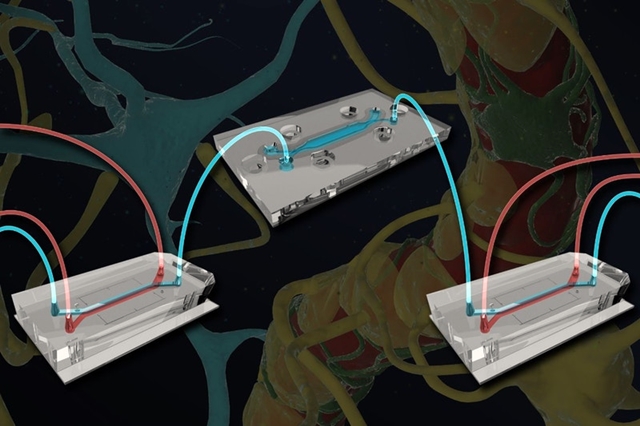
Blood-brain barrier chip illustration. The brain tissue chip, middle, is connected in both directions to blood vessel chips to trace the flow and composition of fluids in and out of the brain. (Wyss Institute, Harvard University)
20 August 2018. Researchers at Harvard University developed a chip model of the blood-brain barrier that protects the brain’s nerve cells and tested the model with the drug methamphetamine. A description of the model, developed at the university’s engineering labs, including the Wyss Institute for Biologically Inspired Engineering, appears in today’s issue of the journal Nature Biotechnology (paid subscription required).
A team from the university’s Disease Biophysics Group led by bioengineering professor Kevin Kit Parker is seeking better technologies for understanding the blood-brain barrier that usually prevents molecules from crossing from the blood stream into brain cells. Blood vessels in the brain form a support network for brain functions, with tightly-packed cells lining blood vessels that allow nutrients like glucose to pass through, but keeping out foreign substances. This barrier also keeps out drugs to treat neurological conditions, such as Parkinson’s or Alzheimer’s disease, and its impaired functioning is also implicated in these disorders. So far, no efficient method is available to penetrate this barrier, preventing some 98 percent of current drugs from reaching the brain or central nervous system.
The researchers note that modeling the brain and its blood vessels is difficult because of the brain’s complexity, which includes many interactions with blood vessels. Their model focuses solely on the blood-brain barrier, and takes advantage of the Wyss Institute’s continuing work with chip devices that simulate biological functions and even entire organs. The model contains 3 chips made of clear polymer plastic, each about the size of a microscope slide. One chip has tiny microfluidic channels etched into the plastic with neurons, or nerve cells, and astrocyte cells representing brain tissue. Astrocytes are cells in the brain that support the signaling functions of neurons. A synthetic cerebrospinal fluid flows through the channels
The 2 other chips represent blood vessels, each having microfluidic channels lined with endothelial cells, like those lining blood vessels, and pericytes that regulate the flow of substances across the endothelial cells, a key part of the blood-brain barrier. A simulated blood flows through the channels in these 2 chips. The 3 chips are then linked together with separate flows of cerebrospinal fluid and blood, with semi-permeable membranes separating the cells and the channels. The system needs 2 blood-vessel chips flanking the brain-tissue chip to compare the state of the fluids before and after interacting with the brain-tissue chip.
The team put their model to a severe test, sending the addictive drug methamphetamine through the channels. Methamphetamine, or meth, is known to disrupt the tight junctions between blood vessels and brain cells, breaking down the blood-brain barrier. In their tests, meth broke down those junctions as predicted, indicating the model can serve as device for simulating some drug-brain interactions. But separate from meth, the researchers also found more subtle metabolic interactions that were previously not known between blood vessel and brain cells that support production of neurotransmitters, signaling chemicals in the brain, and other supporting amino acids.
“The big breakthrough here,” says Parker in a Wyss Institute statement, “is that not only have we created a new model for studying the effects of drugs on the human brain, along the way we teased out the communication networks between cells in a way that never could have been done with traditional brain research techniques.”
Co-author Donald Ingber, director of the Wyss Institute, is also a founder of the company Emulate Inc. that develops and commercializes organ-simulating chips. Ingber chairs Emulate’s scientific advisory board, while Parker is a member of that board. The following video tells more about the blood-brain barrier chip project.
- Tiny Soft Robots Designed for Surgery, Diagnostics
- 3-D Print Advance Creates More Accurate Medical Models
- Computer-Designed Heart Valves Operate Over Long Term
- Gut Tissue From Stem Cells Simulated on Organ Chips
- Artificial Muscles Designed for Soft Robotics
* * *

 RSS - Posts
RSS - Posts
[…] News article: https://sciencebusiness.technewslit.com/?p=34315 […]